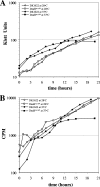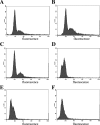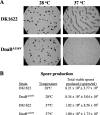The Myxococcus xanthus developmental program can be delayed by inhibition of DNA replication
- PMID: 17905977
- PMCID: PMC2168630
- DOI: 10.1128/JB.01361-07
The Myxococcus xanthus developmental program can be delayed by inhibition of DNA replication
Abstract
Under conditions of nutrient deprivation, Myxococcus xanthus undergoes a developmental process that results in the formation of a fruiting body containing environmentally resistant myxospores. We have shown that myxospores contain two copies of the genome, suggesting that cells must replicate the genome prior to or during development. To further investigate the role of DNA replication in development, a temperature-sensitive dnaB mutant, DnaB(A116V), was isolated from M. xanthus. Unlike what happens in Escherichia coli dnaB mutants, where DNA replication immediately halts upon a shift to a nonpermissive temperature, growth and DNA replication of the M. xanthus mutant ceased after one cell doubling at a nonpermissive temperature, 37 degrees C. We demonstrated that at the nonpermissive temperature the DnaB(A116V) mutant arrested as a population of 1n cells, implying that these cells could complete one round of the cell cycle but did not initiate new rounds of DNA replication. In developmental assays, the DnaB(A116V) mutant was unable to develop into fruiting bodies and produced fewer myxospores than the wild type at the nonpermissive temperature. However, the mutant was able to undergo development when it was shifted to a permissive temperature, suggesting that cells had the capacity to undergo DNA replication during development and to allow the formation of myxospores.
Figures





Similar articles
-
DNA replication during sporulation in Myxococcus xanthus fruiting bodies.Proc Natl Acad Sci U S A. 2005 Oct 4;102(40):14428-33. doi: 10.1073/pnas.0506969102. Epub 2005 Sep 23. Proc Natl Acad Sci U S A. 2005. PMID: 16183740 Free PMC article.
-
DNA replication during aggregation phase is essential for Myxococcus xanthus development.J Bacteriol. 2006 Apr;188(8):2774-9. doi: 10.1128/JB.188.8.2774-2779.2006. J Bacteriol. 2006. PMID: 16585738 Free PMC article.
-
Using a phase-locked mutant of Myxococcus xanthus to study the role of phase variation in development.J Bacteriol. 1995 Jul;177(14):4089-96. doi: 10.1128/jb.177.14.4089-4096.1995. J Bacteriol. 1995. PMID: 7608083 Free PMC article.
-
Genetics of gliding motility and development in Myxococcus xanthus.Arch Microbiol. 1995 Nov;164(5):309-23. doi: 10.1007/BF02529977. Arch Microbiol. 1995. PMID: 8572884 Review.
-
Intercellular signaling in Myxococcus development: the role of C factor.Trends Genet. 1991 Nov-Dec;7(11-12):361-5. doi: 10.1016/0168-9525(91)90256-p. Trends Genet. 1991. PMID: 1668187 Review.
Cited by
-
Small acid-soluble proteins with intrinsic disorder are required for UV resistance in Myxococcus xanthus spores.J Bacteriol. 2011 Jun;193(12):3042-8. doi: 10.1128/JB.00293-11. Epub 2011 Apr 22. J Bacteriol. 2011. PMID: 21515768 Free PMC article.
-
During heat stress in Myxococcus xanthus, the CdbS PilZ domain protein, in concert with two PilZ-DnaK chaperones, perturbs chromosome organization and accelerates cell death.PLoS Genet. 2023 Jun 20;19(6):e1010819. doi: 10.1371/journal.pgen.1010819. eCollection 2023 Jun. PLoS Genet. 2023. PMID: 37339150 Free PMC article.
-
Cell division resets polarity and motility for the bacterium Myxococcus xanthus.J Bacteriol. 2014 Nov;196(22):3853-61. doi: 10.1128/JB.02095-14. Epub 2014 Aug 25. J Bacteriol. 2014. PMID: 25157084 Free PMC article.
-
A multifunctional enzyme is involved in bacterial ether lipid biosynthesis.Nat Chem Biol. 2014 Jun;10(6):425-7. doi: 10.1038/nchembio.1526. Epub 2014 May 11. Nat Chem Biol. 2014. PMID: 24814673
-
Tracking of chromosome and replisome dynamics in Myxococcus xanthus reveals a novel chromosome arrangement.PLoS Genet. 2013;9(9):e1003802. doi: 10.1371/journal.pgen.1003802. Epub 2013 Sep 19. PLoS Genet. 2013. PMID: 24068967 Free PMC article.
References
-
- Biswas, E. E., P. H. Chen, and S. B. Biswas. 1994. Structure and function of Escherichia coli DnaB protein: role of the N-terminal domain in helicase activity. Biochemistry 33:11307-11314. - PubMed
-
- Biswas, E. E., and S. B. Biswas. 1999. Mechanism of DNA binding by the DnaB helicase of Escherichia coli: structural domains involved in ATP hydrolysis, DNA binding, and oligomerization. Biochemistry 38:10919-10928. - PubMed
-
- Biswas, E. E., and S. B. Biswas. 1999. Mechanism of DNA binding by the DnaB helicase of Escherichia coli: analysis of the roles of domain γ in DNA biding. Biochemistry 38:10929-10939. - PubMed
-
- Bonhoeffer, F., and H. Schaller. 1965. A method for selective enrichment of mutants based on the high UV sensitivity of DNA containing 5-bromouracil. Biochem. Res. Commun. 109:93-97. - PubMed
Publication types
MeSH terms
Substances
Grants and funding
LinkOut - more resources
Full Text Sources

